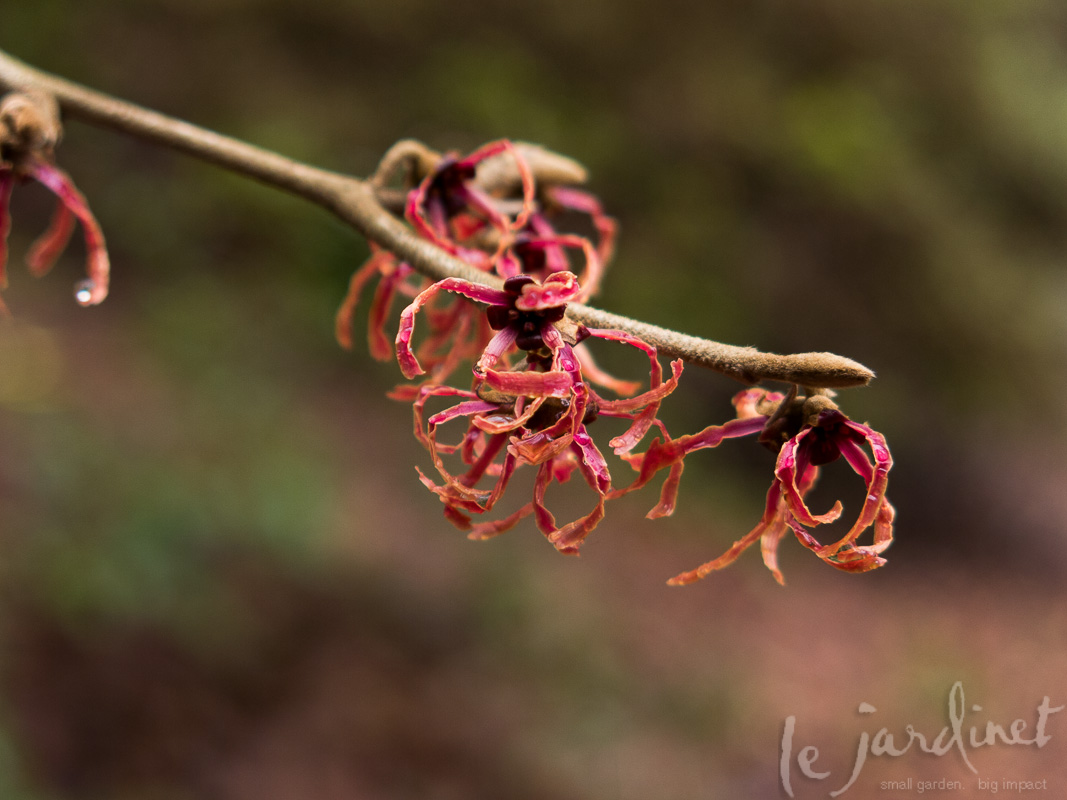Scratch and Sniff
Seattle is having an unprecedented mild spell which tempted me out to visit the winter garden at the University of Washington arboretum this weekend. The birds were singing, the frogs were….doing what frogs do, the hummingbirds were dipping and diving and people were swooning. Really? Yes really. Pure olfactory overload – the witch hazels are in full bloom, the sweetbox is flowering, some of the Oregon grapes still have fragrant blooms and the daphne are just getting started. So for those of you buried under snow or battling icy winds, here is a little witch hazel Scratch and Sniff from Seattle to cheer you up.
Witch hazel (Hamamelis species)
Witch hazels (Hamamelis sp.) are small trees or large deciduous shrubs originating from North America (H. ovalis, H. virginialis, H. vernalis), Japan (H. japonica) and China (H. mollis). Many of today's favorites are a hybrid between H. japonica and H. mollis known as Hamamelis x intermedia from which cultivars such as Jelena (coppery orange) and Diane (red) have been propagated.
Gives these beauties room to spread – some can reach 15' tall and wide! I too am guilty of 'tucking' them into a corner….
Pruning can be tricky and I don't recommend it except to remove suckers. Those are the branches which stick straight up (the natural habit is of sideways or fan shaped growth). You may also see suckers from the base of the main trunk which again grow straight up. The general consensus is to remove these when the shrub is completely dormant (in winter) to reduce the possibility of stimulating new growth at that point. If you must prune for size then do so after flowering but before summer so that new buds have a chance to set for the following year.
Selecting for fragrance
While all witch hazels are fragrant some are more so than others. These are noted for their exceptional scent;
Gold Crest, Arnold Promise, Boskoop
Selecting for flower color
Yellow; Gold Crest, Arnold Promise, Sandra, Sweet Sunshine, Pallida
Red; Diane, Agnes, Birgit, Foxy Lady
Orange; Jelena, Aphrodite, Gingerbread
Selecting for bloom time
The bloom time may vary from year to year, from one area to another and is weather dependent but this general guide will help you select a couple of cultivars that will provide you with an extended dose of swoon-worthy fragrance!
January-March; Chinese witch hazel (H. mollis)
February-March; Japanese witch hazel (H. japonica)
Fall; H. virginiana This native species is hardy in USDA Zones 3-8, spectacular in autumn as flowers at the same time as its leaves turn golden yellow
Late winter/early spring ; H. vernalis
Late spring – April; Orange Encore ( H x intermedia 'Orange Encore')
Selecting for fall color
Arnold Promise – yellow
Diane – orange, gold and purple!
Jelena – orange and red
H. virginiana – yellow
Selecting for size/shape
Most witch hazels are typically as tall as they are wide, ranging from 10-15' but these are notable exceptions
Narrower profile – Arnold Promise, Sweet Sunshine
Weeping – Lombart's weeping witch hazel (Hamamelis vernalis 'Lombart's Weeping').
Basic cultural requirements
Full sun or partial shade but flowering is best in full sun
Average, moisture retentive, acidic soil
Typically hardy in zones 5-8
Want to know more?
Last day to vote!

My other blog www.fine-foliage.com, co-authored with Christina Salwitz is a FINALIST in the Craftsy Blogger Awards contest for the BEST INSTRUCTORS BLOG .
We would both be SO honored to have your vote and if you are so inclined to share this post as we are on the last day voting! Thanks in advance for ALL of your amazing support!







